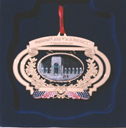
| USA For Democracy and Freedom By engaging in World War II the USA brought democracy and freedom to the world - according to the master narrative that is still valid today. The Cold War seems to confirm this basic idea. This narrative has been renewed again and again in the context of the Vietnam War in the 1960s and after September 11 th , 2001. Although the war in the Pacific has its fixed place in the memory of the Americans, the exhibition concentrates on the European perspective. Not only the victory, but also the liberation of the concentration camps plays a major role in the American mind. World War and genocide were fused together into one thought in the first decades after the War. American broadcasters reported extensively in 1961 about the Eichmann trial in Jerusalem, a further confirmation of the basic idea. Democracy and tolerance were defended by the intervention of the US Army in the Second World War. A separation of the concepts of World War and genocide only came about after the broadcast of the television series "Holocaust" in 1978. In the 1990s an independent culture of commemoration was integrated into the story of freedom and justice in the USA. The Holocaust Museum in Washington, erected in 1993, is among the most famous projects in this context. It is located at the National Mall and therefore belongs to the complex of important buildings that represent America; in this way the Holocaust Museum has also become part of America's master narrative of the War and victory. |
|
| Until the late 1970s there was no clear-cut conceptual separation between World War II and the genocide. This view was reinforced by the news coverage at the end of the War. At the time, pictures were published in the press which, both disillusioning and dreadful, entered the collective memory of the Americans. They showed victims of torture in the Nazi concentration camps. The pictures disappeared very quickly from the media, but their effect on American consciousness should not be underestimated. They deal not only with the liberation of the concentration camps, but rather with the liberation of tortured people from a brutal regime which was able to be brought to an end by the victory of the Allies. | |
| The discussion about the position of the Second World War in cultural public affairs has still not come to an end. This is illustrated by the erection of a monument for veterans of the War at the Mall in Washington D.C. Advocates of this monument welcome it as a long overdue tribute to the most successful heroic commitment of the United States on the stage of world history ever. Private donations were gathered to erect the monument. For this purpose a number of collector's items with the name or picture of the monument were sold. One such example is this piece of jewellery which frames an oval cartridge with a picture of the monument and is decorated with American flags. In the meantime the monument has been inaugurated on the Mall, the government mile. | |
| Most of the posters from the time of World War II have a nostalgic aura. Some posters now seem antiquated in a problematical way, while others have accrued new importance as cultural icons. For example, the poster with the slogan "We Can Do It!" showing a female factory worker flexing her biceps became a feminist cult image and was often reproduced on coffee cups, T-shirts and other collector's items. | |




